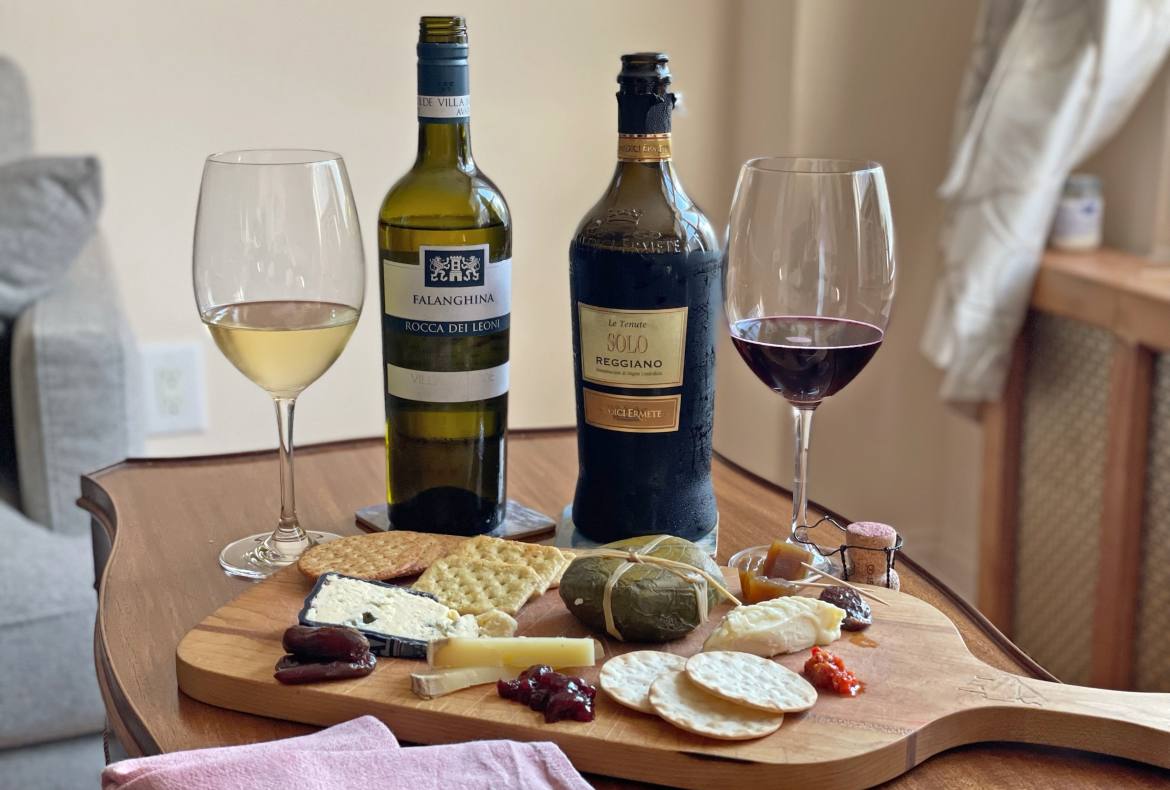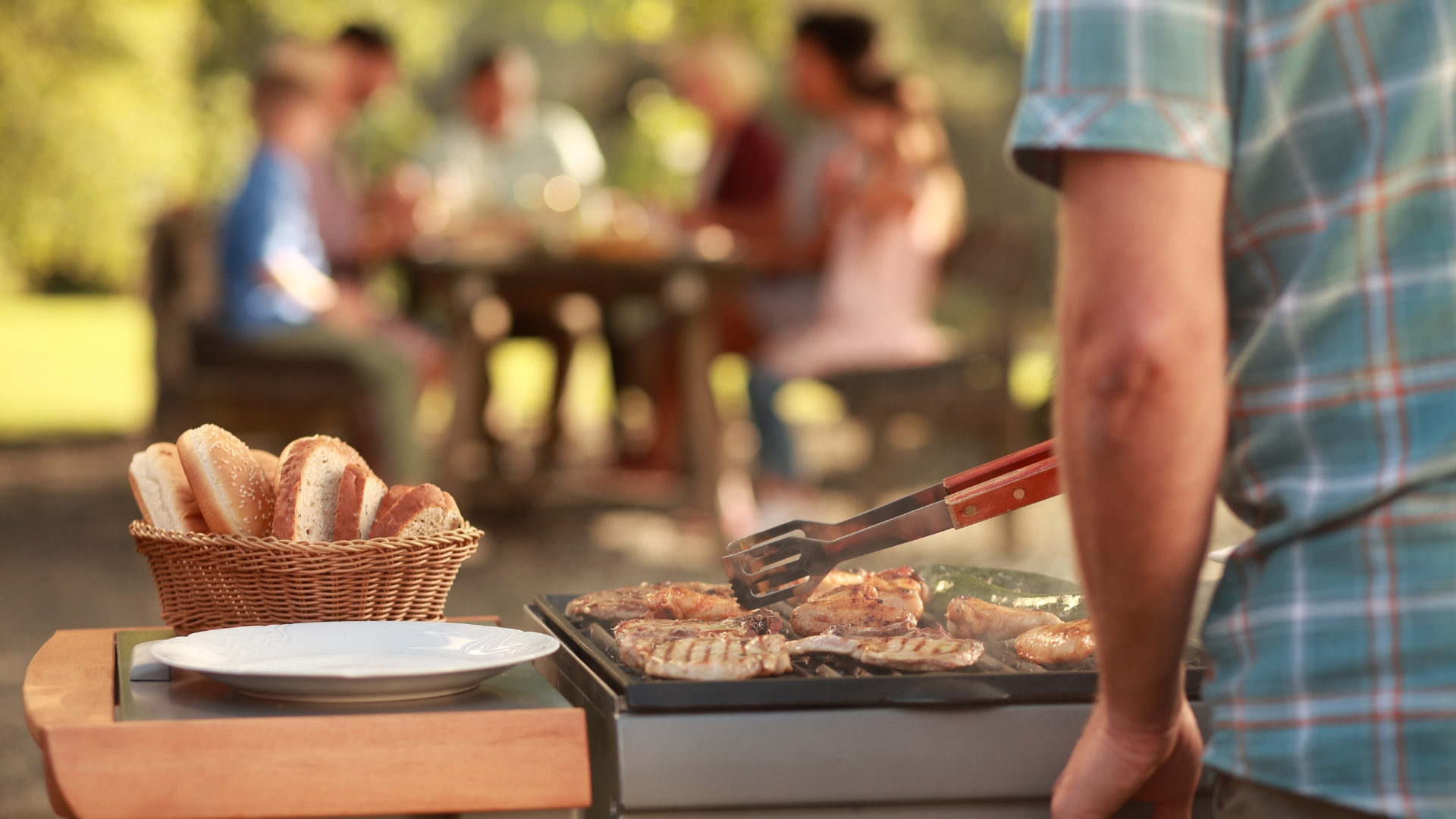Saying “wine and cheese” is like saying “peanut butter and jelly” or “pancakes and syrup,” and not just because the whole is—if not greater than—just as delicious as the sum of its parts! These two ancient products also share many traits in common: they are both fruits of fermentation, can have layers of complexity that develop with age, and are influenced by terroir.
Terroir is an inherently tricky thing to define. At its broadest definition, it’s tied to a sense of place that is apparent when you taste the wine (or cheese). Wine terroir encompasses the microclimate, the elevation, and the soil where the grapes are grown. Cheese terroir encompasses the cellars where it is stored and aged, the humidity in the air, and most significantly, the grasses and food the animals eat. Alpine grasses, wildflowers, herbal mixes from arid landscapes: these flavors affect the animals’ milk, and ultimately, the cheese.
Stress factors in the environment affect both wine and cheese, but in opposite directions: whereas vines stressed from low soil nutrients and scarce water produce better grapes, of course this isn’t true for the animals. It has been shown that happy animals produce better-tasting milk and, therefore, cheese.
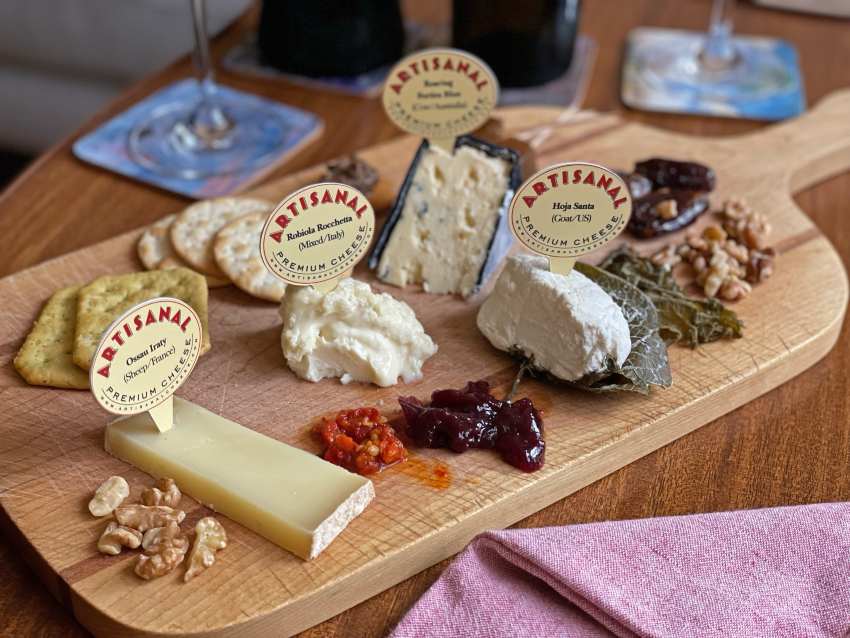
Two Wines That Are Supremely Easy to Pair with Cheese
Here’s a rule of thumb: when in doubt, choose a white wine or a sparkling wine to pair with cheese. White wines will never overpower a cheese, whereas the tannins or red fruit flavors in red wine could clash with delicate cheeses. And sparkling wines—white, red, and rosé—have high acidity and a good, cleansing feel mouthfeel due to their effervescence. This means your tastebuds will not be as quick to tire out and you can enjoy more of that great, creamy cheese you’re noshing on.
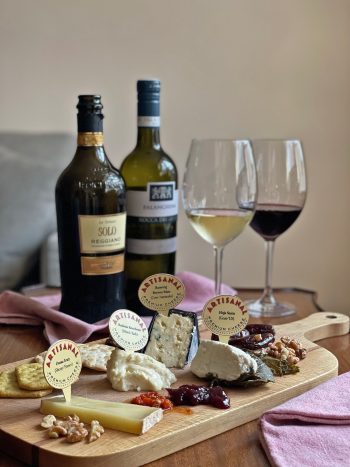
The wines in my arsenal:
Villa Matilde Falanghina Campania IGP – This wine is a stunner. I didn’t realize how much I love Falanghina, but I’ll be on the lookout for it more. The Falanghina from Villa Matilde (Campania, Italy) is honeyed and herbal, with fruity tropical notes of pineapple and white peach. The acidity is well-balanced with its medium body, and the complex notes help it pair with a wide range of cheeses for fun results. Villa Matilde Falanghina is a good reminder that Italy’s white wines are under-discovered.
Medici Ermete Solo Reggiano Rosso DOC – This is a dry, fruity red Lambrusco from one of the best Lambrusco producers. It has bright notes of juicy red raspberry, red currant, and ripe wineberries (I promise, they’re real…and no, I don’t mean grapes). It is highly quaffable. And at 11.5% ABV, it doesn’t get to your head. Tannins are there, certainly, because it’s a red wine, but they don’t grip your palate, and as such make this great for cheese pairing. Medici Ermete Solo is a good reminder that Lambrusco is under-rated!
Exploring Terroir through Cheese
These four cheeses from Artisanal Premium Cheeses are each reflective of where they come from, spanning four countries and three continents: their cheese terroir shines through. And while the old adage “what grows together, goes together” is a helpful way to pair wine and food, these cheeses all pair successfully with the above two Italian wines, both of which you’d do well to have on hand for any number of cheese pairings.
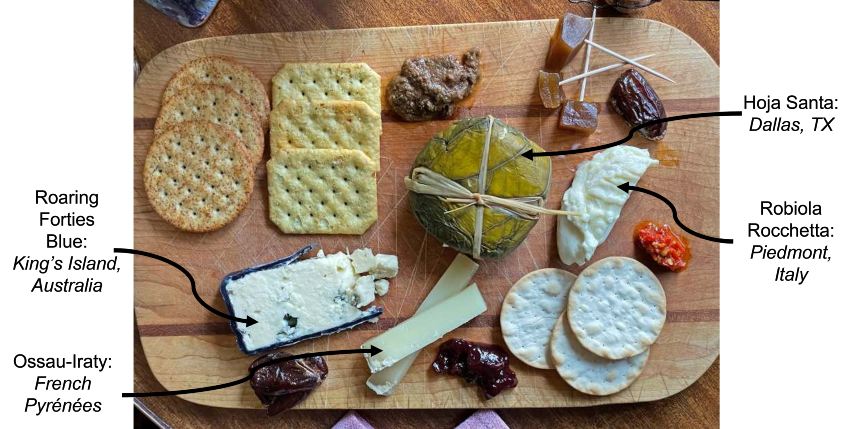
Ossau-Iraty – France: OH-so ear-AH-tee
The Ossau-Iraty is an AOC, or Appellation d’Origine Controlee, of France: a culinary delicacy that’s protected, and carefully made according to age-old rules and traditions, for its heritage and typicity. Only one other goat’s milk cheese has this status, Roquefort. Black-faced Manech sheep graze in high Alpine pastures in the summer in the western Pyrénées Mountains, where they feed on seasonal wildflowers and fresh grasses, reflected in the flavor of the cheese. This one paired very well with the herbal notes of the Falanghina; I especially liked it with walnuts, bringing out its nuttiness, and black olive tapenade, emphasizing the cheese’s savoriness.
Hoja Santa – Dallas, TX: OH-ha SAHN-tah

I’d never tasted a cheese like this before (and I’ve tasted many cheeses!). This goat’s milk cheese comes wrapped in a leaf of local hoja santa plant, native to the area where the cheese is produced in Dallas, Texas. The plant imparts subtle notes of anise, mint, and sassafras to the cheese. Put down your Tex Mex and eat Hoja Santa instead! Or…pair it with a spicy local dish, because I really liked it with a dollop of hot pepper sauce (specifically Trader Joe’s Italian Bomba Hot Pepper Sauce) plus the Falanghina; or with a juicy date, which helped it pair perfectly with the Lambrusco.
Roaring Forties Blue – King Island, Australia

You can’t get much more terroir-driven than a moldy cheese, because the mold, of course, is a product of the environment. But this blue cheese has an even stronger pedigree of terroir: it is made with what is deemed the “sweetest milk in the land,” which means the cows must be super happy with their diet of special grasses. According to legend, in the 18th century, straw mattresses occasionally washed ashore from French and English shipwrecks along the island’s coast. There, still-viable seeds found fertile ground and grew into dinner for these happy cows. I’m a huge fan of moldy cheese, and the intensity of this matched incredibly well with Lambrusco: the red fruit notes are a perfect pairing for the sharp pungency. Try it with dark jam, dried dates, or—my personal favorite—sweet, pickled watermelon rind (purchased my jar of Bradford Watermelon Rind Pickles in a Gastro Obscura vending machine in Union Square, NYC).
Robiola Rocchetta – Piedmont, Italy: ROH-be-OH-lah roh-KET-tah
I’ve waxed poetic about this triple-cream cheese already; see here for my notes (a few words: buttery, rich, with complex textures). As for terroir, it’s a milky mix from cow, sheep, and goat, all of which are raised in the Apennine Mountains right next to Liguria, just 5 miles from the sea, in a little comune called Bosio. Bosio also encompasses much of the Natural Park of Capanne di Marcarolo, all of which means these lucky animals have a diet rich in foliage and spend many happy hours frolicking in nature. This cheese paired well with the Falanghina when spread on a simple water cracker, and when I added a date or berry jam to the mix, the Lambrusco won the day.
Are you curious to taste these cheeses and wines yourself? Gather your friends, because today’s your lucky day: Head on over to the Wine365 Shop for the wine bundles and cheeses!
